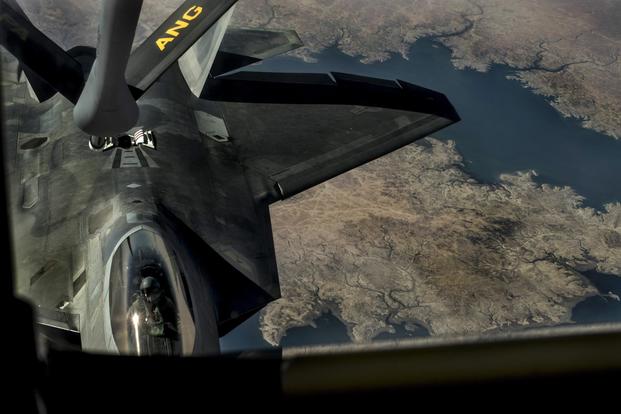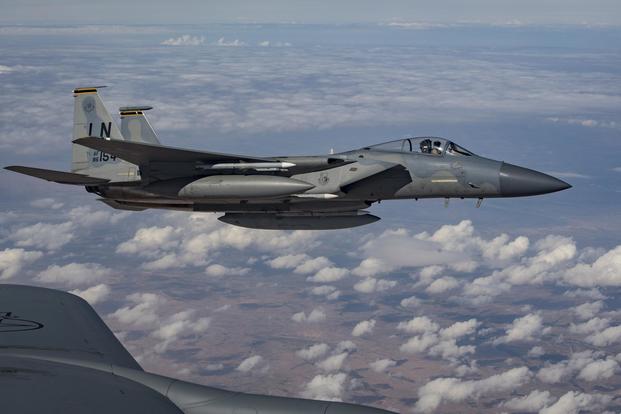The F-22 Raptor stealth fighter has been part of the air campaign against the Islamic State in Iraq and Syria since operations against the group began in 2014.
But not anymore. At least, not for the time being.
The Air Force's Raptors, from the 1st Fighter Wing and 94th Fighter Squadron at Joint Base Langley-Eustis, Virginia, came home last fall. Instead of the fifth-generation fighter, the F-15C Eagle is now on flight lines in the Middle East for Operation Inherent Resolve (OIR) missions, according to Air Combat Command.
"The United States Air Force deployed F-15Cs to the [Air Forces Central Command area of responsibility] in early 2019," ACC spokeswoman 2nd Lt. Lilia Calvillo told Military.com on Thursday. Air Force Magazine first reported the swap March 5.
Related content:
- The F-22 in Syria: Deconflicting, Not Dog-Fighting
- Why the F-22 Raptor Didn’t Get the Air-to-Air Kill in Syria
- Did the Air Force Dash Hopes for Building More F-22s?
"The F-15C model type was specifically requested by AFCENT and, as they stated, it is not a switch between aircraft but rather [the F-15C] provided a unique set of capabilities," Calvillo said.
ACC said it has not been determined whether the F-22s will return. The Raptors are normally stationed at Al Dhafra Air Base, United Arab Emirates, when operating in the theater.
The F-22 has played a critical role in intelligence-gathering during the conflict. With advanced stealth technology and powerful sensors, the aircraft has often been the first coalition plane in hostile airspace after a major incident.
Such was the case after the U.S. downings of Syrian aircraft in 2017, as well as the U.S. Navy's Tomahawk missile strike on al Shayrat Air Base that April.
"The F-22 was necessary over Syria during the period of most intense U.S. operations," said retired Air Force Lt. Gen. Dave Deptula, dean of the Mitchell Institute for Aerospace Studies.
"It acted as a 'sensor-shooter' and was most valued for its ability to go anywhere over Syria, collect critical information, share it with the rest of coalition forces, and thereby dramatically increase the situational awareness of the rest of the force," said Deptula, who was the Air Force's first deputy chief of staff for intelligence, surveillance and reconnaissance and an F-15 Eagle pilot. His son, Lt. Col. David "Ghost" Deptula, is an F-22 pilot.
But the retired general said it's also necessary for the F-22 to get some downtime as the Air Force is racing to ramp up mission-capable rates for its elite fighters, such as the F-22, F-35 Joint Strike Fighter and F-16 Fighting Falcon.
In October, then-Defense Secretary Jim Mattis ordered the Air Force and the Navy to increase the mission-capable rates of the Pentagon's premier fighter jets to more than 80 percent by the next fiscal year, requiring a major boost in maintenance and sustainment for dozens of fourth- and fifth-generation aircraft.
"Mattis established a goal of achieving an 80 percent mission-capable rate, and the F-22 needs some recovery time to be able to meet that objective," Deptula said. Mission-capable rates refer to the aircraft's ability to perform its mission or deploy at a moment's notice.
Because the F-22 fleet is small, it has challenges, he told Military.com this week.
The fleet has started to reorganize for more effective use.
Following Hurricane Michael, which damaged most structures at Tyndall Air Force Base, Florida, as well as dozens of stealth jets, the Air Force moved its remaining F-22 fleet, dividing the aircraft between Langley-Eustis; Joint Base Elmendorf-Richardson, Alaska; and Joint Base Pearl Harbor-Hickam, Hawaii.
Last July, the Government Accountability Office said the F-22 is rarely employed to its fullest potential, due to maintenance challenges and fewer opportunities for pilot training, as well as the fleet's inefficient organizational structure.
"Unfortunately, [then-Defense Secretary Robert] Gates terminated the F-22 at less than 50 percent of the military requirement and so it is stretched thin," Deptula said.
The Air Force originally wanted at least 381 Raptors, but production ceased in 2011 at 187 aircraft.
More than 160 F-22s belong to active-duty units; the remainder are with Air National Guard elements.
While some aircraft have come out of active status for testing purposes, the Air Force has 183 aircraft in its inventory today. Four were lost or severely damaged between 2004 and 2012.
Deptula said, "The F-15 can handle the much less involved effort involving force application against the remnants of the Islamic State, and the significantly reduced threat environment."
-- Oriana Pawlyk can be reached at oriana.pawlyk@military.com. Follow her on Twitter at @Oriana0214.














